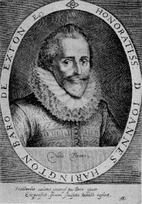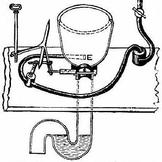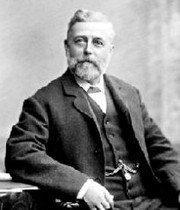1596: Sir John Harrington

The water closet stems from noble origins. In 1596, Sir John Harrington, the grandson of Queen Elizabeth I set out to improve sanitation conditions for his grandmother and himself.
In referring to both the sanitation practices of the time and his new invention, Sir Harrington said, “This devise of mine requires not a sea full of water, but a cistern, not a whole Thames full, but a half a ton full, to keep all sweet and savory.”
Harrington’s invention was quite simple. This device had a seat, a bowl and behind it a cistern of water for washing away the contents. This device was the first known water closet to use running water.
In referring to both the sanitation practices of the time and his new invention, Sir Harrington said, “This devise of mine requires not a sea full of water, but a cistern, not a whole Thames full, but a half a ton full, to keep all sweet and savory.”
Harrington’s invention was quite simple. This device had a seat, a bowl and behind it a cistern of water for washing away the contents. This device was the first known water closet to use running water.
1775: Alexander Cummings

In 1775, Alexander Cummings received the first patent for a water closet. Cummings’ idea was to improve on the water closet invented by John Harrington. Like Harrington’s water closet, Cummings’ toilet used gravity to aid the flow of water to the bowl.
But more importantly, Cummings used a valve trap to secure the area between the bowl and the pipes that took the waste to the sewer. This valve trap aided in helping the water efficiently flush all the waste to the sewer. Additionally, the trap stopped foul odor from reaching the bowl and coming into the room.
But more importantly, Cummings used a valve trap to secure the area between the bowl and the pipes that took the waste to the sewer. This valve trap aided in helping the water efficiently flush all the waste to the sewer. Additionally, the trap stopped foul odor from reaching the bowl and coming into the room.
1861 Onwards: George Jennings, Thomas Crapper and Thomas Twyford

Building on the concepts of Cummings, three British entrepreneurs took the toilet into the next century. George Jennings, Thomas Crapper, and Thomas Twyford proved to be the most successful toilet manufactures in England.
Jennings designed a closet that siphoned the water, creating greater water pressure entering the bowl. This cleaned the bowl better than other water closets had.
Thomas Twyford increased the beauty of the toilet. He hid the working parts of the toilet with porcelain. This was an aesthetic and functional addition. Porcelain made cleaning much easier, and provided a more pleasing site.
Thomas Crapper (right) developed a pull chain that reduced the noise and amount of water needed for the toilet.
Jennings designed a closet that siphoned the water, creating greater water pressure entering the bowl. This cleaned the bowl better than other water closets had.
Thomas Twyford increased the beauty of the toilet. He hid the working parts of the toilet with porcelain. This was an aesthetic and functional addition. Porcelain made cleaning much easier, and provided a more pleasing site.
Thomas Crapper (right) developed a pull chain that reduced the noise and amount of water needed for the toilet.
